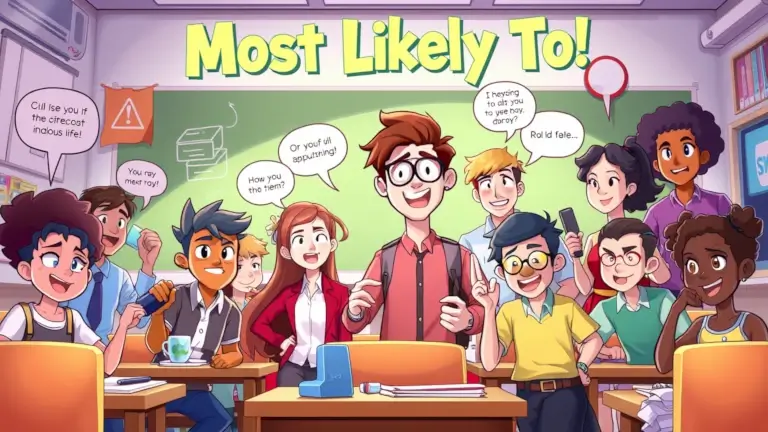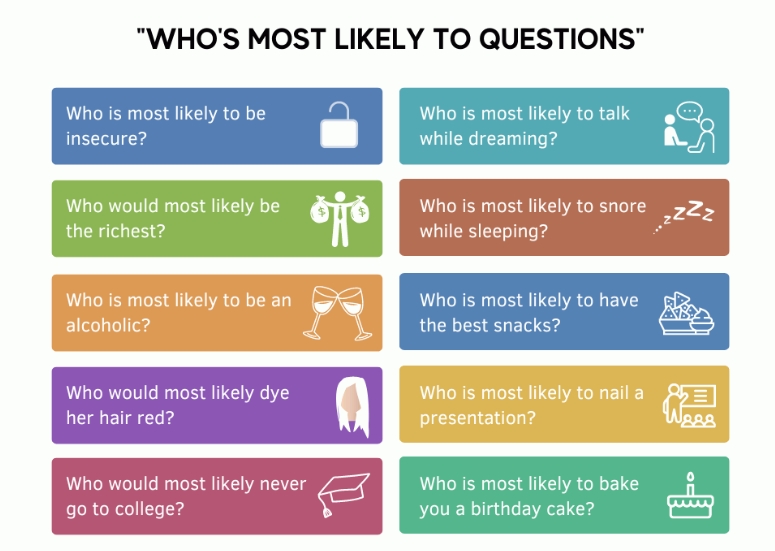

Who Is Most Likely To Questions
The heart of the Who Is Most Likely To game lies in the questions themselves. These prompts are designed to spark laughter, surprise, and insight. A well-chosen question can turn a simple round into a memorable moment. That’s why selecting, organizing, and even customizing your question list is key to making the game enjoyable and suitable for your group.

What Makes a Good “Who Is Most Likely To” Question?
A strong question is clear, short, and easy for everyone to understand. It should apply to most people in the group so no one feels left out. Good questions balance humor, realism, and a bit of unpredictability. They should be general enough to relate to many personalities but specific enough to create funny or revealing answers. You can also adjust the tone of your questions—some groups prefer light and silly prompts, while others enjoy absurd, bold, or even deep questions.
Here’s what to keep in mind when choosing or writing questions:
- Keep the language simple and direct
- Avoid inside jokes unless all players understand them
- Mix easy, silly, and bold questions for variety
- Don’t repeat similar prompts too often
- Make sure everyone feels comfortable answering
Categories of Questions
Dividing your questions into themes helps tailor the game to different moods and groups. Below are several categories, each with examples:
Fun and Lighthearted
- Who is most likely to laugh at the wrong moment?
- Who is most likely to eat dessert for breakfast?
- Who is most likely to accidentally wear mismatched shoes?
Slightly Embarrassing (But Safe)
- Who is most likely to forget someone’s name right after hearing it?
- Who is most likely to trip in public?
- Who is most likely to get caught singing out loud with headphones on?
Personal and Thoughtful
- Who is most likely to keep a childhood toy?
- Who is most likely to remember everyone’s birthday?
- Who is most likely to write in a journal every day?
Hypothetical or Absurd
- Who is most likely to survive in a zombie apocalypse?
- Who is most likely to get abducted by aliens and enjoy it?
- Who is most likely to become famous by accident?
Work or School-Related
- Who is most likely to show up late with coffee in hand?
- Who is most likely to turn in an assignment at the last minute?
- Who is most likely to lead a group project without trying?
Creating Custom Questions

Writing your own questions is a great way to personalize the experience. Custom prompts can refer to shared events, unique group traits, or personal habits known among players. When writing questions:
- Use shared memories for humor
- Avoid anything that targets one person negatively
- Match the tone to the group’s comfort level
- Test the question aloud to make sure it flows naturally
You can even make rounds based on themes like travel, food, awkward moments, or future predictions.
Tips for Managing Your Question List
As your list grows, keep it organized for easier play:
- Use headings or color codes for different categories
- Remove outdated or overused questions
- Rotate in new prompts regularly
- Create separate lists for family, friends, coworkers, or kids
Having a strong question set ready makes it easier to start the game anytime. Whether you’re using printed cards, a shared document, or just reading from a phone, the quality of the questions will shape the pace and tone of the game.
